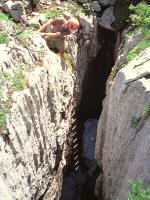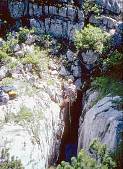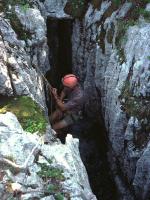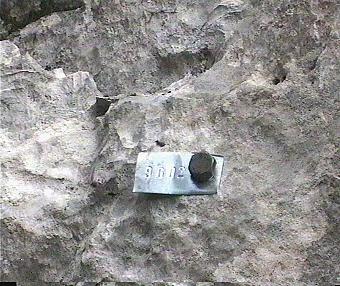
 Bolt placing:
Bolt placing: 
Much of the area of the Loser Augst-Eck plateau is rough limestone pavement (karren), liberally covered with dense areas of dwarf pine, and interspersed with small cliffs, open shafts and snow patches. The latter, in particular, can change the appearance of the plateau from year to year, and even from week to week in the summer. Getting from one point to another may involve detours to avoid any of these obstacles, and the whole effect is very disorientating. There are few landmarks recognisable from a distance or from a variety of angles, and little chance to relate the ground to the 1:25000 Austrian Alpine Club map. Prospecting is either a matter of searching for promising-looking caves with a draught, or shaft bashing many open holes in the hope that one will go. This latter approach is often a waste of time, but just a few of them lead to really significant finds!
(Typical shaft bashing, often easiest on ladders: Adam Cooper near Top Camp in 1993. Bolt placing usually easier on rope, but still in T-shirt & shorts!)
All of this has made any systematic prospecting difficult, so there is still the chance of a significant discovery quite close to Top Camp or to other known caves. Life is made even more difficult through sloppy recording in previous years. Hence it is very important that any cave which has been looked at is marked and documented, to avoid duplication of effort. Very small caves are usually marked with a simple painted cross to indicate that they are worth no further effort, however, nowadays we are not allowed to mark things with paint. More significant caves get a number, and a written description. The aim is to link all such caves in to existing surface surveys, which in turn are tied to a number of fixed points located by laser theodolite/rangefinder from local trig. points.
The web pages contain as much description as we have of every cave we know about. To avoid any possibility of errors, this includes some info on caves not explored by CUCC, though for reasons of Austrian Kataster politics, these are not publicly accessible on the "live" web site.
We now have a fancy clickable map showing the locations of all the caves we have information on with tables showing which pieces of information we have and what information still needs to be gathered.
The following information is at least six years out of date. Do not rely on it being current.
In the tables (and the cave descriptions), bearings are quoted with a series of standard abbreviations for landmarks, which gives a good indication of which ones are most useful.
There is also a table of which numbers are CUCC ones and of numbers which appear on entrances which are wholly misleading, the Cock-Ups.
Note that there is still much missing information about many caves which appear in the "known" and "marked" lists. Though marked, this may not be correctly with their Austrian Kataster number. The aim is to mark all of these correctly with a metal tag bearing their 'official' number over the next few years. Also, many known caves do not have surface surveys to their entrances.
One problem that has recently arisen is a prohibition on painting numbers on entrances within the Naturschutzgebiet (Nature Reserve) area. The Austrians have for a while been marking caves with a numbered alloy tag bolted to the cave entrance. This also has the advantage of a definite fixed point to take the survey to.
From 1996, we have also had to abandon the system (which we believed worked pretty well) whereby we had a block of numbers allocated from the Austrian Kataster, which we could use to number newly found caves. Nowadays we have to produce documentation before we get an 'official' number, which usually means an extra visit with someone who knows the cave's location in the year following exploration. Such a someone will not necessarily exist, which is a recipe for the number of "missing" caves increasing rather than decreasing. However, it is the Austrians' kataster, and we have to work with their system.

An example tag - CUCC 96/02
To overcome this limitation, and try to stop losing caves in which we have invested effort, CUCC now applies its own unique number to each new cave, ideally at the time of discovery, using a rock anchor and a tag which can be replaced when an 'official' number tag is available. As of 2000, the standard practice has been to allocate initial numbers of the form "year-nn", e.g. 2003-01. This means that the cave can be identified when refound, even if no-one who knew where it was came out in subsequent years. Clearly, a good surface location is also pretty essential. There are also a number of caves tagged with numbers of the form "year-xx-nn" where xx are the initials of the discoverer (eg 2002-AD-01), although this system is vaguely deprecated.
Anything longer than 10m needs a number, a survey of appropriate accuracy, and location information (bearings from entrance to known points and description of route to entrance as a minimum - surface surveys are really required for caves within a reasonable distance of existing known points, a GPS fix is probably a convenient compromise in the short term). If a cave is not readily apparent from the immediate area, bearings or a GPS fix will be found to be inadequate to refind it, and a good sketch or photographs of the entrance and its surroundings will be necessary as well.
Caves which require further exploration should be marked "-". Caves which have been fully explored and surveyed marked "|+|". This includes minor holes less than 10m in length. (Note that prior to 1996, completely explored caves were marked "+". Any un-numbered caves found so marked need to be explored again and documented (in the "Noted" list, as a start). A number as above should be allocated if they exceed 10m in length).
There are many other caves marked just with a "+" symbol and a few which just have bolts and no numbers. In the past, any cave which could not be seen not to go just from a surface look has been marked with a "+" to show that it has been looked at but didn't go anywhere significant. We are supposed to record these for the Austrians, so if you find one, please mark it with a unique identifier and record where it is, even if you don't have time to re-explore it at the time. This will help us to assess how many of these caves there are, and to target areas where there are lots first. Overall, this should reduce the amount of work needed to "catch up".
Having come upon a known cave, and decided on the action needed from the tables, you can find out more about the cave by looking at the database of cave descriptions (links from the tables or from the Index to all caves). This exists mainly to ensure that anyone (not just CUCC) finding a cave marked or previously explored by CUCC can find out all we know about it.
For CUCC's caves, we must supply at least a certain minimum of information to the Austrians, which includes an accurate location, state of exploration, name/marking, description and some sort of survey. Obviously for significant caves, we will want a proper drawn up survey, and the aim should be to do a survey right from the first exploration - if the cave ends, this saves having to go back again later ! If you find a cave for which adequate information is not in the database, then at worst document the lack, and at best, go out and create the missing documentation!
As other groups also work in adjacent areas to ours, it is clearly important that the information is widely available, to avoid clashes of interest or duplication of effort. All CUCC's finds are documented here, together with any other caves which we have information on, which we are permitted to publish. We will be very pleased to receive any information on other caves in the area, to make this more complete. It is in no-one's interest to reexplore known cave, or to intrude on someone else's ongoing project ! There is a limited amount of information in the database on caves not explored by CUCC, for which we are not permitted to make the data publicly available - none of this information has been checked in the field and is likely to be out of date, if not just plain wrong. The data are included for completeness and should help CUCC during expeditions. We may be able to make the data available (through password-protected access to those net pages) to other groups with a bona fide need.
(but only revisions to content, not typos and link bugs...)